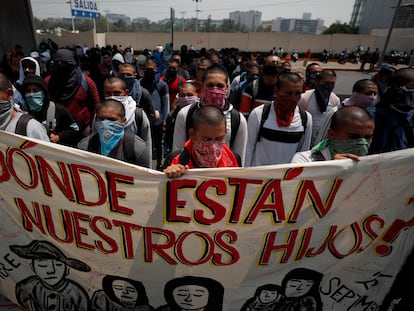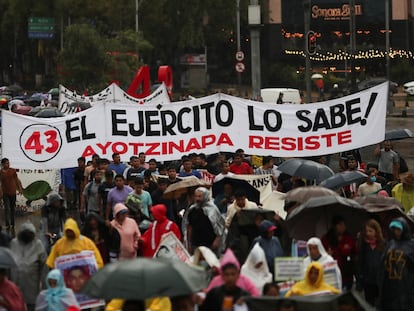Second report from Ayotzinapa case commission in Mexico ignores families’ demand for military intelligence documents
The text, to which EL PAÍS has had access, suggests several locations near Iguala as the possible destination of the disappeared student-teachers. The report also includes screenshots of chats that had been dismissed as unverifiable

The second report of the presidential commission investigating the Ayotzinapa case in Mexico has ignored the main request of the families of the 43 victims: access to dozens of military intelligence documents which, they claim, would contain information about the attack. The Ayotzinapa case refers to the brutal attack against a group of rural students in Iguala in the State of Guerrero, on September 26 and 27, 2014, and the disappearance of 43 of them. The Interdisciplinary Group of Independent Experts (GIEI), which the Inter-American Commission on Human Rights dispatched to Mexico, has investigated the case, along with a special unit of the Attorney General’s Office, and the presidential commission, headed by the Undersecretary of the Interior, Alejandro Encinas.
The GIEI previously indicated that the Mexican Army spied on the communications of Guerreros Unidos, the criminal group that attacked the students almost a decade ago. It also asserts that crucial information about the fate of the 43 students appears in those exchanges uncovered by the military.
On Wednesday, Encinas officially presented the second report on the commission’s findings. The document, to which EL PAÍS has had access, does not include any mention of those exchanges. It does, however, suggest nine areas near Iguala as possible places where the victims were buried.
The 133-page report also references in a veiled manner the content of the screenshots that appeared in the first report, which was presented in August last year. The screenshots — which were dismissed by the GIEI as unverifiable — contained messages allegedly exchanged between alleged members of Guerros Unidos, their family members and their network of allies in government institutions.
The second report from the commission was released just hours after the Mexican government shared a similar — but much shorter — document called: “Ayotzinapa. Narrative of the Facts According to the Investigation.”
Sources close to Encinda said the document, which was posted on the Interior Ministry’s website, is part of the second report from the presidential commission. But while the two texts look similar, there are notable differences. For example, the document on the Interior Ministry’s website does not include the logos or the name of the commission.
The confusion caused by the near-simultaneous release of the two documents is reminiscent of what happened when the first report was published. After it was presented in August 2022, the Mexican government tried to address criticism that the investigation had made no new findings. It held a second presentation days later and qualified some of the data included in the report. Encinas said that an Army general had ordered six of the 43 student-teachers to be killed days after the attack. The problem was that this information came from the unverifiable chats in the report, which were later dismissed.
Just like last year, the chaos has been going on for days. Last week, Encinas presented the second report to the families of the 43 in a private meeting. At the time, the families accepted the contents of the document. A person who was at the presentation told EL PAÍS: “It is a more professional work that gives a good account of the whole process, including the facts and the issue of historical truth.” Encinas barely mentioned the unverifiable screenshots.
But since the presentation last Tuesday, everything has changed. The families and Mexican President Andrés Manuel López Obrador met on Wednesday at the National Palace. The meeting was tense. The families insisted that the government hand over military intelligence documents, claiming that they include conversations from the criminal network in Iguala that took place on September 26, 2014, when the fate of at least 17 student-teachers was decided.
The families, who are aware of the GIEI’s investigations, argue that the existence of these military intelligence documents suggests that there could be many more, hundreds in fact. The GIEI claims that these unknown documents could include new intercepted conversations and therefore more information on the attack and what happened to the students. Last Wednesday, they asked the government to hand over dozens of military documents created between April and October 2014. But the president looked the other way, and repeated the same argument made by the Army: these documents do not exist.
The dispute was to be resolved on Monday. López Obrador summoned the families again to the National Palace, while he bought time to prepare his next step. It was believed that he would make a last-ditched attempt to call on the Secretary of Defense to find the documents. But this did not happen. Nor did he meet with the families. In his absence, Encinas and other Cabinet members sat down with them and read them a report, according to one person present at the meeting. That report was “Ayotzinapa. Narrative of the Facts According to the Investigation,” the same one posted by the Interior Ministry on Tuesday.
This new narrative — seemingly whipped up between last Tuesday and Monday — has enraged the families of the Ayotzinapa victims. Vidulfo Rosales, the lawyer representing the families, criticized the new version of events when he left the National Palace on Monday. “Encinas said that the students had been infiltrated, that there was a dispute between organized crime groups, reducing the responsibility to organized crime, leaving out the role of Army and the authorities,” he said.
Rosales also pointed out that the document gave much more importance to the chat screenshots, even though they had been dismissed as unverified. The report on the Interior Ministry website makes clear references to these conversations, including an exchange in which the wife of an alleged Guerreros Unidos member known as El Chino talks to the daughter of the mayor of Iguala, Jose Luis Abarca. The daughter says that her father is very angry and has ordered that the “merchandise” be recovered and those involved punished. The “merchandise” likely refers to drug shipments sent by Guerreros Unidos shipments to the north. Abarca — who has been linked to the criminal group since the start of the probe — would have ordered the attack, according to the unverified message.
The differences do not end there. In addition to being 100 pages shorter than the official report, the Interior Ministry document makes constant accusations against Gildardo Lopez Astudillo, alias El Gil, one of the leaders of Guerreros Unidos at the time. This is particularly true of the section of the document that discusses the moment when the criminal group disappeared the students. El Gil, who became a protected witness for the Attorney General’s Office (FGR) in 2019, has accused the military of being involved in the attack against the students. He even went so far as to say that Army members took one group to a barracks in Iguala before handing them back to Guerreros Unidos.
Places
Over 10 pages, the second report discusses the possible places where the 43 students were taken. According to the text, it’s “certain” that the victims were divided into at least three groups.
Some of the students were taken by the criminals and Iguala and Cocula police to a northwest area of Iguala, the site of the attack. This took place after they went through a police facility, known in the area as “barandilla.” Not much more is known about the other victims.
But beyond that, everything is pure hypotheses. The second report includes testimonies from protected witnesses, police offices, alleged criminals and statements obtained by the former team sent by the National Human Rights Commission.
This evidence points to several possible places. One testimony argues that the victims were taken to a colony on the outskirts of Iguala, known as Pueblo Viejo. Another that they were brought to Loma de Coyotes, a place a little south of Pueblo Viejo.
Another spot mentioned is Huitzuco and the road leading to that municipality. In recent years, investigators have found links between Huitzuco police with the Guerreros Unidos. Officers from that municipality reportedly took a group of students from the other scene of the attack, the Palace of Justice in Iguala.
The report also talks about Los Tilos Ranch, a Guerreros Unidos cells with a strong presence in Iguala and Huitzuco. The ranch in question operated on the northern exit of Iguala. According to testimonies compiled by the commission, this cell used acid to dissolve the bodies of their victims.
Also listed is La Carnicería ravine, a spot in Cocula, south of Iguala, where, in 2020 and 2021, investigators found the remains of two of the 43 missing students: Jhosivani Guerrero and Christian Rodríguez. The commission does not explain how their remains could have got there. None of the hypotheses link the ravine with other sites listed.
As it did in its first report, the commission discards the hypothesis that the students were burned in a garbage dump in Cocula, the main theory of the Enrique Peña Nieto administration (2012-2018), which investigators now consider to be a cover-up.
Chat screenshots
Both the second report from the commission and the document on the Interior Ministry website make reference to the unverified chat screenshots that had been dismissed from the first report.
The second report says that it asked Meta if the screenshots were compatible with the WhatAapp design “available in Mexico between September 2014 and September 2015, for the Android operating system.” The company replied, “It is not impossible, through screenshots any other way, to validate the existence or not of communications.”
Despite this, the report continues: “That is, it is not possible to ensure that the screenshot messages are true or false. While this means they cannot be prosecuted, by cross-checking and validating them with information from different sources, we were able to open new lines of investigation.”
The document adds that in November 2022, the commission delivered to the Prosecutor’s Office a detailed analysis of the contents, characters and locations of the messages, including 154 relevant events that were supported by other evidence. The goal was to see whether they could be verified or not. In 99 of these instances, there is at least one mention of them in police files and other sources consulted.
In other words, although the report does not directly mention the contents of the screenshot conversation, it includes them indirectly. For example, on page 28, it speaks about an alleged conversation between Army Captain José Martínez Crespo, who is accused of the forced disappearance of the 43 victims and a member of Guerreros Unidos. In this exchange, they say that they had revised the trucks thoroughly and not discovered anyone. The message would be alluding to the police facility know as “barandillas,” which did receive a visit from Crespo that night. The problem is the message cannot be verified.
The report also mentions an alleged exchange between El Chino’s wife and her cousin, in November 2014, in which they talk about the Guerreros Unidos cleanup operation, which, apparently, was trying to erase all traces of the attack against the students. In the conversation, it’s said that an engineer had been kidnapped to dig up and move the bodies.
Once again, while the exchange may have taken place, it can’t be verified. In its new report, the commission incorporates these messages when they confirm some part of the account of what happened, which is pointed out in other evidence. However, far from underpinning known versions, these messages — which have been obtained in recent years — could be used to try to tilt the investigation in one way or another. In this way, they could control the outcome of the investigation.
Sign up for our weekly newsletter to get more English-language news coverage from EL PAÍS USA Edition
Tu suscripción se está usando en otro dispositivo
¿Quieres añadir otro usuario a tu suscripción?
Si continúas leyendo en este dispositivo, no se podrá leer en el otro.
FlechaTu suscripción se está usando en otro dispositivo y solo puedes acceder a EL PAÍS desde un dispositivo a la vez.
Si quieres compartir tu cuenta, cambia tu suscripción a la modalidad Premium, así podrás añadir otro usuario. Cada uno accederá con su propia cuenta de email, lo que os permitirá personalizar vuestra experiencia en EL PAÍS.
¿Tienes una suscripción de empresa? Accede aquí para contratar más cuentas.
En el caso de no saber quién está usando tu cuenta, te recomendamos cambiar tu contraseña aquí.
Si decides continuar compartiendo tu cuenta, este mensaje se mostrará en tu dispositivo y en el de la otra persona que está usando tu cuenta de forma indefinida, afectando a tu experiencia de lectura. Puedes consultar aquí los términos y condiciones de la suscripción digital.
More information
Archived In
Últimas noticias
Most viewed
- Sinaloa Cartel war is taking its toll on Los Chapitos
- Oona Chaplin: ‘I told James Cameron that I was living in a treehouse and starting a permaculture project with a friend’
- Reinhard Genzel, Nobel laureate in physics: ‘One-minute videos will never give you the truth’
- Why the price of coffee has skyrocketed: from Brazilian plantations to specialty coffee houses
- Silver prices are going crazy: This is what’s fueling the rally











































